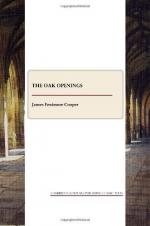The Kalamazoo and its mouth were soon far behind, and le Bourdon no longer felt the least apprehension of the savages left in it. The Indians are not bold navigators, and he felt certain that the lake was too rough for the savages to venture out, while his own course gradually carried him off the land, and out of the track of anything that kept near the shore. A short time produced a sense of security, and the wind appearing to fall, instead of increasing in violence, it was soon arranged that one of the men should sleep, while the other looked to the safety of the canoes.
It was about nine o’clock when the fugitives made sail, off the mouth of the Kalamazoo; and, at the return of light, seven hours later, they were more than forty miles from the place of starting. The wind still stood, with symptoms of growing fresher again as the sun rose, and the land could just be seen in the eastern board, the coast in that direction having made a considerable curvature inland. This had brought the canoes farther from the land than le Bourdon wished to be, but he could not materially change his course without taking in one of his sails. As much variation was made, however, as was prudent, and by nine o’clock, or twelve hours after entering the lake, the canoes again drew near to the shore, which met them ahead. By the bee hunter’s calculations, they were now about seventy miles from the mouth of the Kalamazoo, having passed the outlets of two or three of the largest streams of those regions.
The fugitives selected a favorable spot, and landed behind a headland that gave them a sufficient lee for the canoes. They had now reached a point where the coast trends a little to the eastward, which brought the wind in a slight degree off the land. This change produced no very great effect on the seas, but it enabled the canoes to keep close to the shore, making something of a lee for them. This they did about noon, after having lighted a fire, caught some fish in a small stream, killed a deer and dressed it, and cooked enough provisions to last for two or three days. The canoes were now separated again; it being easier to manage them in that state than when lashed together, besides enabling them to carry both sails. The farther north they got the more of a lee was found, though it was in no place sufficient to bring smooth water.
In this manner several more hours were passed, and six times as many more miles were made in distance. When le Bourdon again landed, which he did shortly before the sun set, he calculated his distance from the mouth of the Kalamazoo to be rather more than a hundred miles. His principal object was to ascend a bluff and to take a look at the coast, in order to examine it for canoes. This his glass enabled him to do with some accuracy, and when he rejoined the party, he was rejoiced to have it in his power to report that the coast was clear. After refreshing themselves, the canoes were again brought together,




